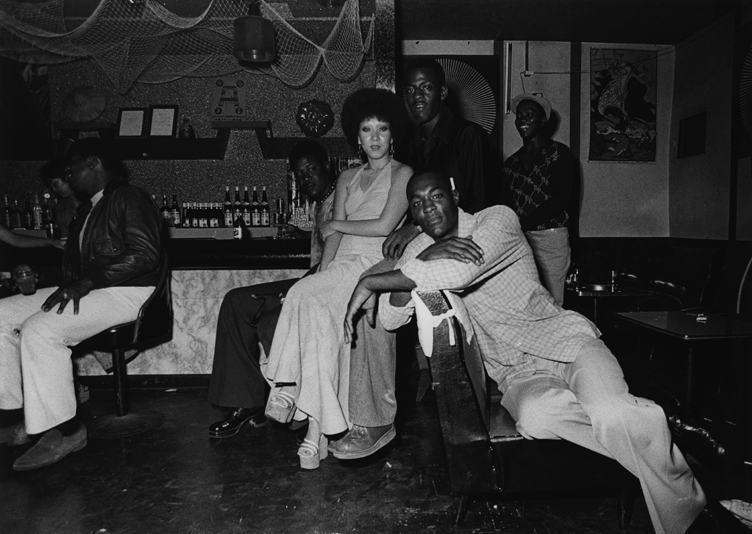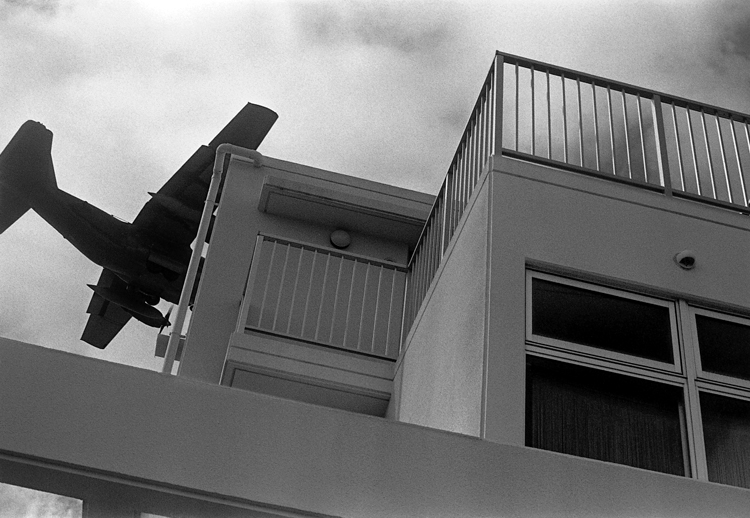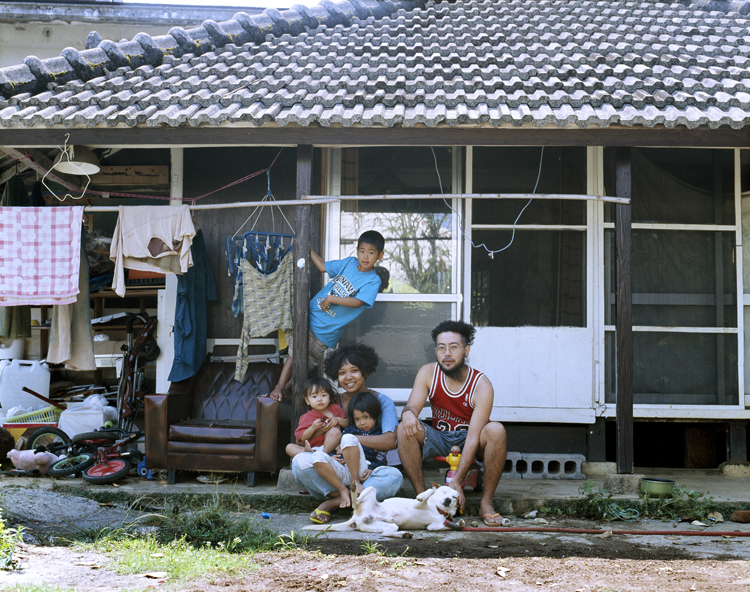石川真生 ISHIKAWA Mao

《赤花 アカバナー 沖縄の女》1975-77年 ゼラチンシルバープリント 36.0×49.0cm
Red Flower:The Women of Okinawa, 1975-77, Gelatin silver print, 36.0×49.0cm
石川真生
ISHIKAWA Mao
1953年、大宜味村(おおぎみそん)(沖縄県)生まれ。沖縄県に在住、活動。
1974年にワークショップ写真学校、東松照明教室に参加し、本格的な撮影活動を始動する。一貫して沖縄を主題とし、1977年に写真集「金武の女たち」の出版を皮切りに、撮影の成果を常に出版物と展覧会として発表し続けている。2004年の横浜美術館での「ノンセクト・ラディカル 現代の写真III」の出品をはじめ、ニューヨークのPS.1や東京国立近代美術館、沖縄県立博物館・美術館の展覧会等発表の場を広げている。ライフ・ワークでもある「大琉球写真絵巻プロジェクト」は、歴史的な事象を再現しながら、琉球王国時代から現代に至るまでの壮大なスケールで構成されるこれまでにない形式の写真を展開している。
Born in Oogimison, Okinawa, 1953. Lives and works in Okinawa, Japan.
ISHIKAWA Mao participated in workshops by the photographer TOMATSU Shomei in 1974 and thereafter launched her full-fledged photographic career. She has consistently engaged with the theme of Okinawa, and in 1977 started publishing the photo collection Kin no Onnatachi, (The Women of Kin). She constantly published the fruits of her photographic ventures, while at the same time working on numerous publications and exhibitions. Beginning with Non-Sect / Radical Modern Photography III exhibition at the Yokohama Museum of Art in 2004, Ishikawa went on to present her work at venues such as PS.1 in New York, the National Museum of Modern Art in Tokyo, and the Okinawa Prefectural Museum and Art Museum. A theme to which she has devoted a lifetime is ”the Great Ryukyu Photograph Embroidery Project”, in which she photographically reproduces a magnificent scale a series of historical incidents spanning the Ryukyu Kingdom era to the present day, while elaborating an unprecedented form of photography.
更新された最新の情報は、画廊のウェブサイトをご覧ください。
Please refer to the gallery’s website for new updates.
http://napgallery.jp/artists/mao-ishikawa/

《FENCES, OKINAWA》2009年 インクジェットプリント 30.3×42.2cm
FENCES, OKINAWA, 2009, Inkjet print, 30.3×42.2cm
米軍機が「普天間飛行場」に降りていく。2009年7月、宜野湾市上大謝名
U.S. Military Aircraft Descending to the “Marine Corps Air Station Futenma.” July 2009, Ueojana, Ginowan City, Okinawa.

《大琉球写真絵巻 パート2》2015年 インクジェットプリント、写真用布、100×3000cm(写真22点)
Dai–Ryukyu shashin emaki (the Great Ryukyu Photograph Embroidery) Part 2, 2015, Inkjet print on fabric, 100×3000cm (22 images)
国際的保護動物、ジュゴンのえさ場でもあるきれいな海に日本政府は米軍のために新たな飛行場を名護市のキャンプ・シュワブ沖に建設するという。沖縄県知事や名護市長を始め県民の反対する声を一切無視し、海を埋め立てるための工事が今、連日強行されている。2トンから45トンの大きなコンクリートブロックを海中に沈めて珊瑚を破壊しまくっている。ならば安倍首相よ、お前が珊瑚の代わりにブロックでつぶされてみるがいい。沖縄人と海の生き物の苦しみを味わうがいい。
The Japanese government announced that it will build a new air station for the US military off the coast of Camp Schwab in Nago City, located in a beautiful ocean that is also a feeding ground for the internationally protected marine animal known as the dugong. Ignoring the protests of the Okinawa governor, the Mayor of Nago, and the people of Okinawa, the Japanese government is currently enforcing the continued daily construction to reclaim land from the sea. Large concrete blocks, each weighing from two to forty-five tons, are submerged into the sea, utterly destroying the coral reefs. Prime Minister Abe, if this is what you want, why don’t you change places with the reefs and experience the feeling of being squashed by the blocks. You should taste the pain of the people and sea creatures of Okinawa.

《大琉球写真絵巻 パート4》2017年 インクジェットプリント、写真用布、 100×3000cm(写真22点)
Dai–Ryukyu shashin emaki (the Great Ryukyu Photograph Embroidery) Part 4, 2017, Inkjet print on fabric, 100×3000cm (22 images)
【親富祖愛(おやふそ・あい)、34歳】
米兵だった父と美容室をやっていた母が結婚して自分が生まれた。ティーダ(長男)が幼稚園生の頃、同級生に「外人」「幼稚園の中で一番黒いよ」と、言われた。「ママ、外人って何?」と聞いてきた。私も学校に入った頃からずっと言われてきた。「洋服が浮いて歩いている」「黒人」。肌の色のことや天然パーマのことはどうしようもない。ティーダに「友だちに言われたらどうしてるの?」と聞いたら、「黙っている」と、言っていた。私も道を歩いている時すれ違いざまに、今でも「クロンボウ」と言われることがある。ティーダが今年、小学校に入学して同級生に「なんでティーダのママは黒いの?」と、言われた。「やっぱり来たか」と思った。「気にしないで」と、答えた。ティーダのクラスだけの問題ではない。ティーダがいるおかげで子供たちの意識が変わればいいさね。差別されているんですよ、で終わるのではなく、なんで差別はいけないのか、それを話したい。沖縄で変えたい。ここから基地の問題にもつながる。自分のやり方はこれだな、と今は思っている。
Oyafuso Ai (34)
My father, who was a black US military soldier, and my Japanese mother, who used to run a beauty parlor, got married and had me. When Tiida (my eldest son) was in kindergarten, his classmates told him that he was “a foreigner” and “the blackest of all in the kindergarten.” He asked me, “Mom, what is a foreigner?” People also made similar remarks to me from the time I had entered school. They would say such things as, “Clothes are floating and walking on their own” and “You’re black.” But I could do nothing about the color of my skin or my naturally curly hair. I asked Tiida, “How do you react to your friends’ remarks?” He replied, “I keep my mouth shut.” Even today, there are times when a person passing by on the street utters “Nigger” at me. This year, Tida became a first grader. As I expected, his classmates asked him, “Why is Tiida’s mom a black?” I said to him, “Don’t you worry about it.” This problem does not apply to Tiida’s classmates alone. Rather, owing to Tiida, the children have the opportunity to change their mindset. We should not end the conversation with “So and so is being discriminated against,” but take it further and discuss why discrimination is bad. I want to change this situation in Okinawa. Such a discussion can also translate to the problem concerning the US military base. At the moment, I feel that this is my way of dealing with the problem.
(Translated by NANPEI Taeko)
All photos credit : ISHIKAWA Mao

